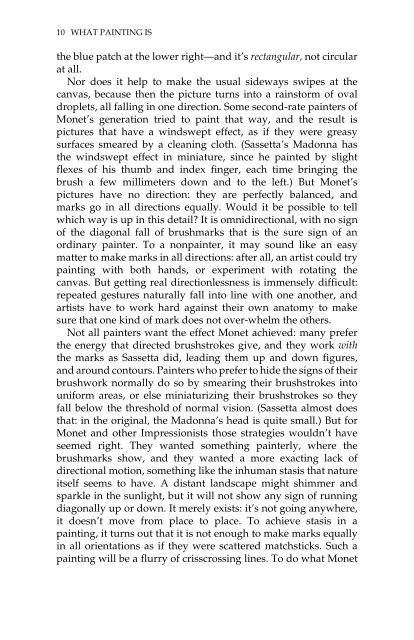What Painting Is: How to Think about Oil Painting ... - Victoria Vesna
What Painting Is: How to Think about Oil Painting ... - Victoria Vesna
What Painting Is: How to Think about Oil Painting ... - Victoria Vesna
You also want an ePaper? Increase the reach of your titles
YUMPU automatically turns print PDFs into web optimized ePapers that Google loves.
10 WHAT PAINTING IS<br />
the blue patch at the lower right—and it’s rectangular, not circular<br />
at all.<br />
Nor does it help <strong>to</strong> make the usual sideways swipes at the<br />
canvas, because then the picture turns in<strong>to</strong> a rains<strong>to</strong>rm of oval<br />
droplets, all falling in one direction. Some second-rate painters of<br />
Monet’s generation tried <strong>to</strong> paint that way, and the result is<br />
pictures that have a windswept effect, as if they were greasy<br />
surfaces smeared by a cleaning cloth. (Sassetta’s Madonna has<br />
the windswept effect in miniature, since he painted by slight<br />
flexes of his thumb and index finger, each time bringing the<br />
brush a few millimeters down and <strong>to</strong> the left.) But Monet’s<br />
pictures have no direction: they are perfectly balanced, and<br />
marks go in all directions equally. Would it be possible <strong>to</strong> tell<br />
which way is up in this detail? It is omnidirectional, with no sign<br />
of the diagonal fall of brushmarks that is the sure sign of an<br />
ordinary painter. To a nonpainter, it may sound like an easy<br />
matter <strong>to</strong> make marks in all directions: after all, an artist could try<br />
painting with both hands, or experiment with rotating the<br />
canvas. But getting real directionlessness is immensely difficult:<br />
repeated gestures naturally fall in<strong>to</strong> line with one another, and<br />
artists have <strong>to</strong> work hard against their own ana<strong>to</strong>my <strong>to</strong> make<br />
sure that one kind of mark does not over-whelm the others.<br />
Not all painters want the effect Monet achieved: many prefer<br />
the energy that directed brushstrokes give, and they work with<br />
the marks as Sassetta did, leading them up and down figures,<br />
and around con<strong>to</strong>urs. Painters who prefer <strong>to</strong> hide the signs of their<br />
brushwork normally do so by smearing their brushstrokes in<strong>to</strong><br />
uniform areas, or else miniaturizing their brushstrokes so they<br />
fall below the threshold of normal vision. (Sassetta almost does<br />
that: in the original, the Madonna’s head is quite small.) But for<br />
Monet and other Impressionists those strategies wouldn’t have<br />
seemed right. They wanted something painterly, where the<br />
brushmarks show, and they wanted a more exacting lack of<br />
directional motion, something like the inhuman stasis that nature<br />
itself seems <strong>to</strong> have. A distant landscape might shimmer and<br />
sparkle in the sunlight, but it will not show any sign of running<br />
diagonally up or down. It merely exists: it’s not going anywhere,<br />
it doesn’t move from place <strong>to</strong> place. To achieve stasis in a<br />
painting, it turns out that it is not enough <strong>to</strong> make marks equally<br />
in all orientations as if they were scattered matchsticks. Such a<br />
painting will be a flurry of crisscrossing lines. To do what Monet


